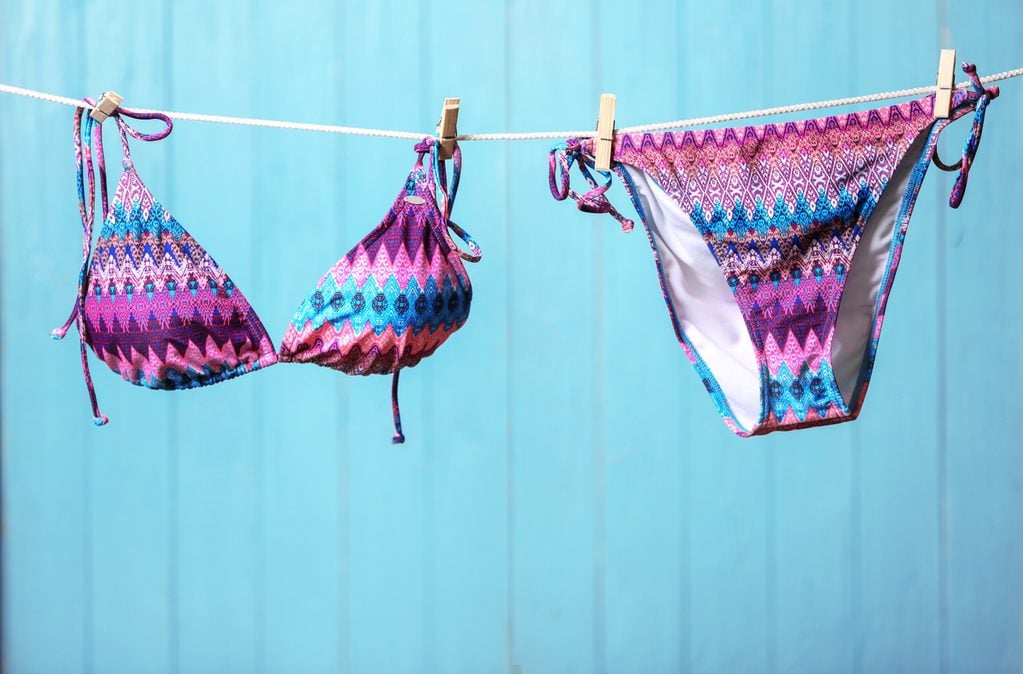Why Is It Called a Bikini, Anyway?
Updated: Aug. 11, 2021

Find out the little-known history behind the tiny two-piece swimsuit, which celebrates its 73rd birthday on July 5, Bikini Day.
It wasn’t that long ago that baring any amount of skin when swimming was considered scandalous. Just over a hundred years in the past, heavy, long woolen garments were the only option for women heading to the beach—definitely not vintage swimsuits we wish could come back in style. But only a few decades after that, the bikini debuted: a bathing suit so small it could fit in a matchbox. What was behind this radical shift in swimwear? And how did the itty-bitty garment called the bikini get its name?
Ancient Roman gymnasts wore early bikinis
Before they were even called bikinis, female ancient Romans wore similar outfits way back in the 4th century. The Villa Romana del Casale in Sicily features mosaics of women playing games in bandeau tops and belly button-bearing bottoms. These garments, though, were meant for sports, not for swimming. Unfortunately, post-ancient times, the trend in women’s clothing became to cover up—and as recreation swimming didn’t really begin until the 19th century, women had little cause to don swimwear at all.
The dawn of the two-piece
The prudish Victorians, although fond of the beach, wore bathing suits that were basically dresses—not very practical for swimming. But fast-forward to the Golden Age of Hollywood in the 1930s and early 1940s, and stars like Ava Gardner and Rita Hayworth were finally appearing in what we’d recognize as an actual two-piece bathing suit—but, the bottoms came up really high, covering the navel to fit in with movie regulations called the Hays production codes. Just a small amount of belly (or actually, rib cage) could be shown.
The bikini debuts
Spurred by fabric rationing in World War II, bathing suits got skimpier and skimpier. Two French designers rivaled to create the world’s smallest suit: Jacques Heim debuted the “Atome,” named after the atom; while Louis Reard came up with an even tinier creation called the “Bikini,” after the atomic bomb testing on Bikini Atoll in the Pacific on July 1, 1946. Fit for a bombshell, the suit was so scandalous he couldn’t find a model to wear it, settling instead for an exotic dancer named Micheline Bernardini. Debuting on July 5, 1946, now known as Bikini Day, the bikini made a splash at a press event at a Paris pool. The navel-bearing string bikini featured only 30 inches of newsprint fabric, guaranteed to make headlines; Bernardini even held up a matchbox, which the suit could fit into.
Reard would later say a swimsuit isn’t a bikini unless it could be pulled through a wedding ring.
The bikini causes scandal
Even after its debut, the navel-revealing bikini was slow to catch on. It was declared sinful by the Vatican and banned by countries including Italy, Spain, and Australia. After bikinis made their first appearance at the Miss World competition in 1951, most beauty pageants decided not to allow them. But we can thank the French for keeping the bikini alive: The suits became popular on the Riviera, due in part to a young Brigitte Bardot donning one during the Cannes Film Festival in 1953. The actress also appeared onscreen in the tiny garment in the French films Marina, the Girl in the Bikini (1952), and later And God Created Woman (1956).
Surf’s up for the American bikini
Slowly, the bikini made its way across the pond. In 1960, Brian Hyland released the hit song “Itsy Bitsy, Teenie Weenie, Yellow Polka Dot Bikini,” a catchy tune that described a young woman’s reluctance to be seen wearing the revealing swimsuit. The song, along with 1960s surf culture in movies and music, brought the garment into the mainstream. Disney star Annette Funicello famously appeared with Frankie Avalon in a series of early 1960s “Beach Party” movies—at first, keeping her navel covered, but eventually sporting a belly button-revealing blue-and-white bikini in one of the films’ later installments. A “wholesome” star wearing the garment prompted more women to buy them.
Hollywood goes bikini crazy
As the swinging 1960s went into full effect, there was no more hiding actresses’ navels (or much of anything else) onscreen. Sporting the most famous film bikini of all time, Ursula Andress emerged from the surf wearing a white bikini and knife belt in the 1963 James Bond film Dr. No. Reportedly, the actress worked with the costume designer to create one that fit just right. In 2001, Andress put the bikini (found in her attic) up for auction at Christie’s, fetching the equivalent of about $50,000.
The Sports Illustrated Swimsuit Issue
Why would a sports magazine feature women in bikinis? The story goes that Sports Illustrated‘s editor was looking for exciting content to fit slower winter months—and the idea of a fashion special was born. The first issue, in 1964, featured model Babette March on the cover in a white bikini. But nowhere else was the argument over whether the bikini heralded a new era of empowerment for women—or a way to put their bodies on display for men’s benefit—better “illustrated” than in the Swimsuit Issue. Today to its credit, SI includes varying body types into the special issue; proving these 9 reasons the phrase “bikini body” should be banished from your vocabulary STAT.
Fun fact: The most expensive bikini in the Swimsuit Issue was the $30 million diamond-studded, very brief garment worn by actress Molly Sims in 2012.
Some bikinis still controversial
In the 1980s, thong bikinis became popular on the beaches of Brazil—and led to the introduction of the “Brazilian wax,” which aimed at removing hair for such a swimsuit. The thong bikini may be a normal sight in Rio de Janeiro, but many U.S. cities and states—including Myrtle Beach and state parks in Florida—still have a ban on suits that expose the buttocks. In other places, such as Barcelona, Spain, it’s illegal to walk around on the street in a bikini: Beachgoers need to cover up when they leave the sand and surrounding area.
The bikini returns to its sporty roots
Remember those ancient Roman athletes in bikinis? Beach volleyball, introduced at the 1996 Olympics, named the bikini its official uniform, as anything else tended to get sand in very uncomfortable places. Popularized by players Gabrielle Reece and, later, the team of Misty May-Treanor and Kerry Walsh Jennings, the sport enacted a new rule in 2012 allowing women to wear shorts and sleeves if they prefer.
Today, more bikini options than ever
Louis Reard’s creation started a revolution in women’s swimwear, leading to even more styles available today and more body types to wear them: There’s the monokini, a one-piece with huge cutouts; the tankini, a two-piece with a longer top and bikini bottoms; even the “burkini,” a version worn by some Muslim women for swimming. Plus, these 12 empowering swimsuit pics prove there is no one bikini body. Bikinis come in halters, bandeaus, and spaghetti straps, with underwire or triangle tops; bottoms can be string, high-cut, or even navel-covering retro cuts, so you can pick the best bathing suits for your body type. Coming full circle, Reard’s company also relaunched in 2017 with a new line of swimwear, including more bikinis.
